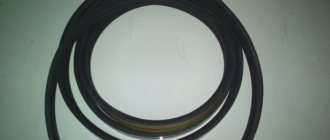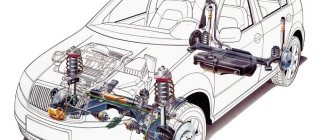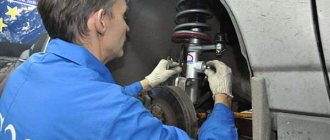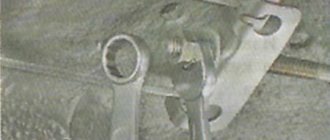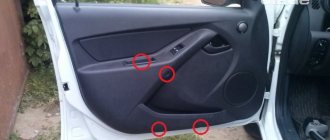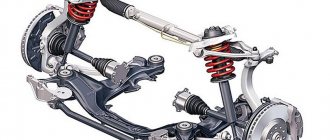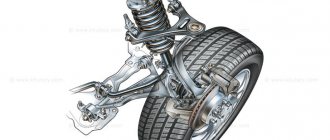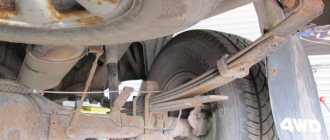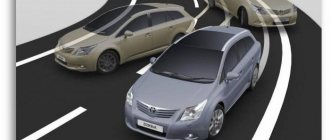Knock in the front suspension
Unfortunately, it is impossible to determine by ear what is actually knocking. Therefore, when performing independent diagnostics, you need to inspect the shock absorbers, tie rod ends, anti-roll bar, front suspension arm, steering knuckle, silent blocks, ball joints. A common cause of knocking is failure of rubber seals. All rubber parts must not be cracked or damaged. If you notice a defect, you must replace them immediately.
Possible causes of knocking and their diagnosis
The cause of the knock can be any part that is part of the suspension. The most common causes of a knocking front suspension are:
Carrying out car suspension diagnostics yourself
- wear of the tie rod end;
- shock absorber malfunction;
- wear of ball joints;
- damage to rubber-metal hinges;
- deformation of shock absorber strut supports;
- wear of supports and suspension arms;
- loosening the nuts and bolts of the system components;
- wear of the cushion and rubber-metal hinges of the rod;
- production of hub bearings;
- large wheel imbalance or deformation of wheel rims;
- settling or breakage of the suspension spring.
Next, we will analyze these and other causes of knocking in more detail. You should start self-diagnosis by checking the condition of the anthers and rubber sealing parts . If they are damaged, they must be replaced. Also pay attention to signs of oil leakage from the shock absorbers.
Malfunctions in the operation of the suspension arms
A possible cause of a knocking sound from the suspension is a malfunction of its levers . This is usually accompanied by poor vehicle handling. Check the operation of silent blocks. To do this, use a pry bar as a shoulder to bend the levers. If there is a malfunction, you will see significant play . For repairs, it will be necessary to replace the silent blocks. To do this, you need to remove the levers and press the old silent blocks out of the hole. Before installing new silent blocks, lubricate the seat to reduce friction. Clean it from dust and dirt in one go.
Shock absorber malfunctions
The shock absorber may knock at the top or bottom mounting point. The reason for this may be the loosening of the fastening bolts or an increase in play in the mounting holes. Visually, wear or breakage of the springs can be determined by the vehicle's seat level. If the spring has sagged too much or is broken, this will be visible from the fit of the body. When driving, a broken spring will make a characteristic sound.
To preserve shock absorbers, it is recommended to fill them with oil of the viscosity specified by the manufacturer (provided that the shock absorbers are dismountable). In winter, never make a sudden start in a cold car. You can damage not only the engine, but also the shock absorbers, since the oil in them is also not warmed up. This will take care of the shock absorber struts and increase their service life.
Often the stand can be the cause of a knock. Especially when driving on uneven roads (knocking on bumps, uneven surfaces) or when a wheel falls into a hole. To check the strut, you need to press vertically on the fender or hood . With a proper stance, the car smoothly returns to its original position. Otherwise, you will hear creaking and sudden movement.
A possible cause of a knocking noise in the strut could be a loose lock nut. This malfunction can be identified by the car swaying while driving and decreased controllability. In this case, noise occurs randomly. The nut must be tightened, otherwise you risk losing control of the car on the road.
Steering problems
Diagnostics of steering rods on VAZ cars
The knocking noise caused by the steering is similar to that produced by faulty shock absorbers. An indirect sign confirming that the cause of the knocking is in the steering is vibration of the steering wheel and knocking on bumps and uneven surfaces.
The front knock, in this case, is the result of the interaction of the rack and the gear moving along it. During operation of the steering system, the contact gap and wear between the rack and pinion increases over time. Therefore, a knock occurs at the point of contact. To diagnose this breakdown, it is enough to jack up the car on one of the front sides and shake the steering rods. If at the same time you feel play, then most likely the dull knock comes from worn bushings. They are repairable, and in any auto store you can find repair kits for replacing bushings.
Rack support
A dull sound when driving on uneven roads may occur due to incorrect operation of the upper part of the front suspension. It has a rubber base, which is a natural shock absorber. However, rubber wears out over time and becomes woody. Because of this, its flexibility and shock-absorbing ability are lost. Unfortunately, the designs of many cars do not allow one to reach this unit and measure the gap between the limiter and the support. However, if this can be done in your car, then know that the distance should be about 10 mm. Typically, knocking in the suspension occurs only on one side, since it is unlikely that the supports will wear out on both sides at the same time.
Support bearing
The sound that a worn support bearing makes is similar to that produced by a damper, but is louder. To detect a breakdown, it is necessary to dismantle the front strut. The peculiarity of its production is the uneven wear around the perimeter of the body. The greatest generation occurs when the car is moving straight. Therefore, knocking is possible when moving in a straight line . If you turn right or left, the knocking stops. If you have such a situation, it means that the support bearing of the car has failed.
Ball joints
On old rear-wheel drive cars (for example, VAZs), problems with ball joints are considered a classic cause of knocking in the suspension. The check must begin by hanging the car on the shock absorber above the wheel where the knock is coming from. Without rotating the disk, you need to try to shake its opposite parts toward and away from you. The procedure must be carried out in two planes , grasping the left and right parts of the wheel, then the top and bottom. If the supports are faulty, you will feel play.
Constant velocity joint (CV joint)
If the CV joint is faulty, then while driving it produces a characteristic crackling sound, especially when turning. When a CV joint breaks down, it has to be replaced because it cannot be repaired.
Uncharacteristic causes of failure
Another reason for knocking could be a loose brake caliper . This is a fairly rare reason, since, as a rule, the caliper is mounted very securely using locknuts. But if the fastening bolts do loosen, the sound of the caliper, especially when braking the car, will be very loud, so it is impossible to confuse it with anything else. Sometimes, especially if the brake pads are of poor quality, they can make a small and dull sound. In some cases, peeling of their working surface may occur. The cause of knocks in the front suspension can also be the stabilizer bar bracket . It has bushings with rubber elements in its design. It is necessary to check their integrity.
Lada Granta suspension device
Front suspension device (diagram)
This car uses an independent suspension with one lever, to which the lower part of the steering knuckle is screwed. Its top is mounted to the shock absorber strut, the operation of which differs from many similar units on domestic cars. When you turn the steering wheel, the fist with the shock absorber strut and the spring placed on it rotates. The shock absorber auger, screwed through a bearing to the upper strut support, remains stationary.
The ball joint provides flexible articulation between the steering knuckle and the suspension arm. The camber angle is adjusted traditionally for front-wheel drive versions of VAZ cars - with a nut with an eccentric on the main shock absorber strut, at the point where it connects with the steering knuckle. The suspension is kept from directional fluctuations by a common anti-roll bar and braces on both sides of the suspension.
Details in the photo
All suspension elements are in the photo below
Knock in rear suspension
Diagnosis of the rear suspension is faster because its design is simpler. There can be several reasons for the knocking sound - worn torque rod bushings (if any), loose wheel bolts, loose or broken exhaust pipe fastening, broken suspension spring coil, loosening of the short torque rod mounting bracket, recoil valve in the shock absorber, rear shock absorber bushings, released axle shaft, pad spacer bar. Also, unknown sounds may be caused by reasons not directly related to the suspension. For example, objects in the trunk, an unscrewed spare tire, and so on.
It is also recommended to check the exhaust pipe mounting and its general condition. After all, a burnt-out muffler produces extraneous sounds that a car enthusiast may mistake for a knock in the rear suspension. In addition, it is necessary to check all pipe fastening elements. If it is not securely fastened, then on uneven roads it can produce a small and dull knock, which the driver may mistake for problems with the suspension.
When diagnosing yourself, you need to check the following components (some of them may be absent on some car models):
- rear suspension guide structure;
- levers (transverse, longitudinal);
- anti-roll bar;
- rear shock absorbers;
- shock-absorbing springs;
- shock absorber cups and brackets;
- rubber bushings;
- rear axle beam;
- compression buffer;
- bearings.
Diagnostics of the guide structure
During the diagnostic process, you must perform the following steps:
- Check the force and condition of the beam, as well as the levers (if any). Make sure there is no deformation on these parts.
- Check the hinges. They may develop cracks due to wear and tear. This also leads to deformation.
It is worth checking the threaded connections of the flanges at their attachment points. Depending on the make and model of the car, they can be repaired or you will have to buy and install new ones. The above work must be performed in a car service center or in a garage with an inspection pit.
Diagnostics of suspension springs
Despite the fact that the steel from which the springs are made is strong, they can fail over time. Their individual coils break, so the spring stops working normally. To diagnose it, it is enough to conduct a visual inspection. In this case, it is worth paying attention to the absence of defects on the spring coils, as well as the integrity of the rubber inserts that are located in the places where they are installed. If a spring fails, it must be replaced; it cannot be repaired.
Rear shock absorbers
Used shock absorber boots
As with the front shock absorbers, it is necessary to diagnose the anthers . If necessary, replace them. When inspecting the shock absorber, you should also pay attention to the absence of oil leakage from its housing. If the shock absorber is collapsible, it makes sense to dismantle it and disassemble it to ensure that the internal elements are in good working order. In this case, it is worth checking the rubber bushings inside, which often fail.
Additional reasons
If you have checked the parts listed above, but the rear knock still persists, you should pay attention to the following things:
- Stopping support. Here they proceed as in the case of the front suspension. When it is skewed, the caliper will make a loud sound, so diagnosing this malfunction is not difficult.
- Wheel bearing. You need to jack up the car completely or just the wheel you want to check. When rotating freely, the bearing should not make noise, knocking or creaking noises. When checking, the brake pad may rub against the disc, the sound of which is very similar to a squeak. Therefore, be careful when diagnosing.
What other components cause knocking?
If you have checked all the components described above, but have not found out the cause of the knocking, pay attention to the stabilizer bushings. As a rule, their wear is accompanied not only by knocking on bumps, but also by squeaking. By the way, it is for this reason that the rear suspension most often creaks.
On some cars, such as the Ford Focus or Renault Duster, the engine mounts are a whole mechanism with rubber bushings. Therefore, the knocking noise may be caused by wear of the bushings. Malfunctions of the supports can only be determined visually by carefully inspecting all engine mounting components.
We are on social networks and messengers: ★ Vkontakte group: ► https://vk.com/oo_dk ★ Facebook group: ► https://www.facebook.com/groups/oo.dk.kz/ ★ Odnoklassniki group: ► https://ok.ru/group/55161239502972 ★ Instagram group: ► @road_control_kz ★ Telegram group: ► @oo_dk ★ WhatsApp group: write to WhatsApp and you will be provided with a link to our group ► 8-777-154 -37-77 ★ Periscope: ► https://www.periscope.tv/denizshima/1kvJpnNgVEMKE?
Cooperation and advertising: ★ COOPERATION: ► ★ WhatsApp: ►8-777-154-37-77
For monitoring police activities: ★ MASTER Card: JSC "Kaspi-Bank": No. 5169 4931 3301 9524 ★ Qiwi wallet
List of the most common reasons
Knocking in the suspension when driving over uneven surfaces is an extremely common problem. In most cases, the sound that appears when the body vibrates when a wheel hits an uneven surface is associated with partial performance of the chassis, but occasionally there are other reasons. The most common reasons are:
- faulty shock absorber strut mounts;
- damage to shock absorbers or their individual elements;
- wear of ball joints, silent blocks, support bearings;
- damage to the steering rack.
These are the most common causes of metallic knocking noises coming from under the car body. Defective suspensions are much less common. Sometimes the engine support components are to blame. Each individual problem is solved in its own way, but most often you simply have to replace the damaged part. The most common cause of the problem is wear of components due to poor quality roads. Since most foreign cars simply do not have any additional chassis protection systems, silent blocks, supports and other elements suffer, which bear the brunt. While reducing damage to the body and other parts of the car, these elements themselves wear out, and very intensively.
First of all, it is worth checking them and replacing them if a malfunction is detected.
You should definitely not repair damaged parts yourself; they must be replaced with factory equivalents. You shouldn’t ignore the problem either, because the longer the knocking continues, the more extensive the damage will be in the end. Try to quickly check all possible causes, and this should be done in this order.
Causes of extraneous noise and knocking
There can be plenty of reasons for extraneous noise and knocking in the front suspension. When parts wear out, the brakes, steering system, and engine can rattle. However, the greatest amount of noise in the presence of defects occurs in the suspension and shock-absorbing units; read more about the Renault Logan front suspension design here.
In order to carry out an independent inspection, and, if necessary, repairs, you will need a lift or inspection hole.
Support stand
For comparison: old and new support strut on Logan
Before you begin inspecting the suspension under the car, first assess the condition of the front strut supports. To do this, you need to open the hood and evaluate the gap on the spring stop cup.
If the gap exceeds 1 cm or it differs relative to the opposite side, this indicates that the supports have sagged and they do not absorb impacts on small bumps, therefore, they need to be replaced.
Shock absorber struts
The presence of a dull knock in parts of the front suspension may indicate defects in one of the shock absorber struts. The easiest way to diagnose is to alternately rock the car on the left and right sides. If there are working shock absorbers, the car will smoothly return to its original position, already on the first or second free play.
The presence of smudges and unsatisfactory condition of the bumpers will also indicate that the rack should be replaced.
Anti-roll bar link
This chassis element is checked when the vehicle is under load. By rocking the car, you should pay attention to the movement of the cup relative to the lever itself. If this element malfunctions, it will jump and make a characteristic knock, which in turn, undoubtedly, is observed when driving on an uneven road.
Inspection and replacement of the stabilizer bar link
The same goes for the anti-roll bar bushings. When they wear out, play and free movement will be felt in the places of contact with the rod itself. Diagnostics and replacement of stabilizer bushings can be carried out both on the ground and with the car suspended.
Silent blocks
The arrow marks the silent block
After the car has been raised, you should check the silent blocks in the suspension arms. In order to determine the degree of their wear, you will need a mount, with the help of which, by moving the lever on the subframe in the longitudinal and transverse directions, you can determine their play, as well as identify rubber defects.
On Renault Logan, the silent blocks are attached to the front suspension arm, so their replacement should be carried out on a removed element.
Spherical bearing
Diagnostics of a ball joint is diagnosed in the same way as silent blocks. By turning and pushing movements (left - right) you should influence the front suspension lever, and if the ball joint is faulty (there is play), moving it will not be difficult.
Ball boot diagnostics
The support on the Renault Logan is pressed into the front suspension arm. Therefore, before dismantling it, the lever must first be removed, and the replacement itself must be carried out using a press. Read more in the material: replacing and diagnosing a ball joint on a Renault Logan.
If the ball joint is sentenced to replacement, then it is important to know which ball joints are better!
Replacing silent blocks
A dull knock in the front suspension usually occurs due to problems with silent blocks and springs. If the reason is silent, then the car's handling will noticeably deteriorate. The only option is to replace the entire set. There is only one way to check whether this is true - carefully examine the front suspension arms. To do this you will need a mount. Using a pry bar as a counterweight arm, bend each front suspension arm. You need to bend in different directions. If there is a malfunction, you will find play, which is why the knocking occurs.
If you can disassemble the structure, then all that remains is to replace the silent blocks in the following sequence:
- Remove all levers.
- Next you need to pull the silents out of their seat. Using a special mandrel they can be easily pressed out.
- Clean the seat from any remaining oil and dirt.
- New silent blocks must be lubricated with machine oil before installation.
This, in fact, is all that is required of you.
Steering rack
A knock in the suspension when turning can occur due to problems with the steering rack. Typically, it is the turning of the steering wheel that causes the sound, which occurs due to play inside the structure. A characteristic feature is that the sound comes from one side and is also accompanied by a noticeable vibration of the steering wheel. The malfunction is especially pronounced on a gravel placer, then vibration is very frequent, although there should not be any at all.
The sound occurs when the steering gear and the rack itself rub against each other.
Occasionally, a similar defect is observed immediately after replacing the bearing in the hubs of VAZ 2109. As a result of the defect, the backlash will increase, which will lead to damage to the elements of the steering structure. To verify the reason, you will need a jack to raise the car:
- Raise the car.
- Take a pry bar and carefully move the tie rods from side to side.
- If significant play occurs (it should be visible to the naked eye), then the problem is worn out bushings that will need to be replaced.
- It is also necessary to tighten the rack nuts to seat it on the gear.
It is rare, but it still happens that the steering wheel and its components are in order, but vibration and knocking are still present. In such cases, attention should be paid to inspecting the steering joints.
The car is ready
About 4 hours later they called me and informed me that the car was ready and I could pick it up. I arrived, paid for the repair using my card, picked up the car and drove home. I tried to drive over bumps and uneven surfaces - surprisingly, there was no more knocking in the suspension!
It’s good that I didn’t change the racks, otherwise I would have had to fork out a considerable amount!
If you have had similar cases, share in the comments. Subscribe to the channel so as not to miss interesting posts about the Lada Grant.
Racks, supports, springs
A strong knock in the front suspension occurs due to impacts on the car body. This happens when the shock absorption system wears out. In rare cases, the shock absorber spring can also be the culprit of the knocking, but this happens extremely rarely, since the springs are the strongest part of the assembly.
The sound occurs on small bumps when the shock absorbers take a sharp blow. The vibration damping system copes very poorly with such an active load, so rapid wear of the elements during frequent driving on uneven roads leads to such consequences. The result is wear of the rubber layer of the support.
To detect a malfunction, you will have to go through the entire rack, remove it along with the support, and for this you need to dismantle the wheel and partially disassemble the chassis. There will be a lot of work. To make sure it is the strut support that is the problem, you need to measure the distance from the support to the rubber stopper. Ideally, there should be no discrepancies, maximum 1–2 mm.
If the reading is higher, you will have to replace the rubber layer of the strut.
If you don’t want to do this yourself, then the service station will do this work much faster, albeit for a fee. Vibration and knocking should disappear immediately after replacement.
It is extremely rare that the cause of a knock is the rack itself, which has become severely worn out due to constant loads. The sound will be very loud, and the car will shake considerably on bumps.
Checking the strut is quite simple: press harder on the hood. If the rack is faulty, the car will sharply return to its original position with a characteristic loud knock, while the body will sway a little.
The source of the sound may be a loose nut inside the mechanism that can be tightened.
Well, the latest option is a complete malfunction of the shock absorber mechanism. This happens as a result of accidents and collisions. At first, no attention is paid to the knocking, but the problem is discovered much later.
Knocking from the front.
Hi all. I had a problem half a year ago. An irritating knock has appeared in the front suspension, it manifests itself only on small uneven roads, and the knock is both on the left and on the right, I changed the ball joints, the steering wheel ends, the knock did not go away, I blame the struts, although they do not leak and the car does not bite. Maybe It's worth replacing the supports. or maybe it's not them? VAZ 21102 car. Thanks in advance.
Open the hood. Turn on 5th gear (the engine is off). Approach from the front. Place one hand on the support bearing of the strut and push the car back and forth. If the support bearing (or something in the strut), then the hand will clearly “hear” extraneous knocking sounds inside the support. Good luck.
So I did. You can feel the blow. Is it better to change everything at once or replace the bearing for now? By the way, which brand is better. Do not offer ss-20!
I pressed on the right wing and then on the left. If the recoil is different, then the struts must be replaced. If there are smudges, the same thing. If everything is normal, only the bearing. Or 2500 rub. both sides and the issue of racks is closed for 2-3 years.
I forgot to write that he needs to cut 2 turns)))))))))))))))))
annoying knocking, manifests itself only on minor road irregularities, and the knocking is both on the left and on the right
The distribution of kinetic energy under equal loads, with 100% recoil efficiency, does not work here. You need advice here. But no one understands you.
I don't understand. Don't you understand? Or no one? They understood for 7 years and now they don’t understand? Strange. I'm getting old apparently.
And what does kinematics have to do with it in this context?
Ahhh the suspension kinematics. Gyyyy. Cool.
nice..
No one touched the steering wheel. When swinging back and forth, the operation of the struts was revealed. If anyone asks, I’ll tell you about the steering rack and springs. That’s a different story and the malfunction is not related to the struts.
The knock could also be from the pad in the caliper.
There are no leaks. It seems to jump around the same. I'll try to replace the bearings. Who knows which brand is more reliable??
There should be no more than 2 “jumps”. As for the brand, go to any auto repair shop and ask the dealers. Because models are constantly changing, they are aware, I think they will give more precise advice.
Have you tried simply tightening the support bearings and struts? And I should also look at the silent blocks.
the nut is tightened just fine
So this is not gud.
You have to be either a fool or a poor person to kill the silent blocks before they make a knock. At the initial wear, they will creak like a cot and the wheel alignment will immediately be disrupted. How can you tighten the support one? It’s “disposable” after all. And the stand is only positioned when it’s removed.
Yes, yes, I know that you are special)))))))))
Naturally, if the silent block on the shock absorber breaks, the wheel alignment is screwed)))))))))
Yeah, and they tighten the bearings on a suspension that is suspended and not loaded with the weight of the car.)))))))))))
The author, if anything, I'm joking. Really tighten the mount and check the tightness of the bearing.
I was talking about silent blocks in the rods, and not about the rubber bushings of the shock absorbers.
The stand assembles perfectly when removed. It is always removed in case of malfunction and when necessary..
Fastening what? The support inside breaks the bearing. Where to pull it? This is not a drop hub.
Yeah, they're not regulated, right?
Spring elasticity. The elasticity of the rack itself, the selection of the model (oil, gas-oil, gas). You install the support bearing, tighten 3 nuts, stick the rack in, tighten it from the top, tighten it from the bottom. Off we go. I just changed it on my daughter’s van. I don’t understand what you’re talking about. Everything is new and assembled. What’s there to regulate? When you remove it, you mark the strut and you can do without camber, but I still went to do it after installation.
Well, yes, as always, you didn’t take into account some points, but you made extra ones. Google it, you'll like it. And then I got tired of typing.
Well I do not know. My daughter drives away, happy, and they also cut off 2 turns. Why do I need Google? I always change it myself if I take it as an assembly. And if I assemble it from pieces, then in the workshop.
They forgot about the steering rack. can also rattle, especially on cobblestones
Other reasons
In addition to all the options described above, the suspension also knocks for other reasons. One of these is brake pads that produce a metallic knock. In such cases, the sound disappears as soon as the brake pedal is pressed. Often this problem occurs after installing new elements or severe wear of old pads.
Any knocking noise in the rear suspension can repeat the problems described above, but this happens extremely rarely due to the fact that most modern car models are front-engined. Since the engine is one of the heaviest parts of the car, the front part of the body bears much more load, and even shock absorbers do not protect against this. The rear of the car is unloaded, and therefore is not subject to such problems.
By the way, knocking noises in the front end may be the result of a worn engine mount.
The rubber inserts of the unit wear out over time, this happens after about 100–120 thousand kilometers of a new car. As a result, when the rubber parts are worn out, any trip on an uneven road will be accompanied by a metallic knock. Additional sound can be produced by the motor itself, the unit of which will be slightly displaced. If the reason is in the support, then you will find carbon deposits on the spark plugs, and when you inspect the support itself, you will find tears.
Let's sum it up
It is worth using various methods to test equipment before replacing. Otherwise, because of one knock, you can change half of the suspension without eliminating the cause of the problem. Therefore, you should always approach diagnostics from different angles and use the services of testing suspension parts at several service stations. You can change parts only if you are sure that certain mechanisms are faulty. You should approach the issue of repair with full understanding so as not to spend too much money on this process. Many novice drivers simply buy every part that they are guilty of, and as a result, repairs are very expensive.
There are certain difficulties in diagnosing the chassis of a modern car. It is not at all clear which element may be causing the knocking. There are a number of possible options, they are all interconnected, and even analysis does not answer the question. Therefore, it is very difficult to use the full picture of the breakdown to purchase the spare parts necessary for repair. Sometimes you have to change parts just at random, not getting the result on the first try. There are various repair options available, but to do so you need to pinpoint the problem. How do you usually diagnose and repair the chassis of your car?
A knock in the front suspension on small bumps is one of the signs that some of the chassis parts are damaged or almost completely worn out. Novice motorists, without much hesitation, take their car to a service station for diagnostics and shell out considerable sums for repairs. However, there is no guarantee that the knocking will disappear and its source will be found. You can not only identify but also eliminate most of the causes that cause knocking on your own.
Front suspension installed with defects
A possible reason for the appearance of knocking on bumps may be the occurrence of defects in the lever system. At the same time, you will notice changes for the worse in the car's handling. The only culprit in this situation is a set of silent blocks.
To check for problems, you need to diagnose the levers. You can do it yourself using a regular mount. To do this, use the pry bar as an extended arm to create a counterweight and bend each of the arms in different directions. If you find significant play in the structure (discrepancy of more than 5-7 cm), then it is worth carrying out maintenance on the suspension.
If the machine has a collapsible structure, then you only need to replace the old set of silent blocks with a new one. The replacement process is as follows:
- First you need to dismantle the levers;
- Then the stage of pressing out the set of silent blocks from the fixed holes occurs. To do this, use a special mandrel;
- Install a new set of silent blocks, having previously generously lubricated each of them to reduce friction during operation. Also, do not forget to clean the mounting surface of the suspension from all dust and dirt before installation.
Tip: If the suspension was supplied with defects from the manufacturer, then in case of an unexpired warranty, you can contact the dealer, and he will be obliged to replace the defective parts free of charge. Also be sure to check the rear axle of the VAZ-2107.
The appearance of malfunctions in the steering
According to experts, the occurrence of knocking on small bumps in the suspension in 70% of cases is associated with the presence of obvious problems in the vehicle components. However, many drivers believe that the problem is related to the shock absorber struts, although the fault lies in defects in the steering.
An external examination and diagnosis of the steering rack will help to find out whether this is true or not. When checking this unit, you will also hear a similar knocking sound as the shock absorber. In this case, you will hear a knock only on one side. Also, an additional symptom that indicates problems in this element is the presence of slight vibration in the steering wheel. Vibration is usually noticeable when driving on gravel roads.
Tip: the sound occurs when the rotating gear rubs against the steering rack structure. This may be a side effect of replacing the wheel bearing on a VAZ-2109.
The problem with the steering rack is the following - the gap between the gear and the rack gradually increases, and the intensity of the element’s operation increases. As a result, during long-term operation of the vehicle, significant wear is formed on the body of the mating surfaces of each pair.
Problems with the rack supports
The upper parts of the supports suffer the most when driving on uneven roads. In this case, most often it is necessary to replace the rubber base, which is necessary to dampen vibration and the resulting excess noise. The sound occurs as a result of loss of flexibility and severe wear of the base.
Often, when sounds appear, the driver begins to manually sort out the entire front suspension, spending a lot of time and money on new spare parts, but the cause of the noise does not disappear. You can identify the presence of a problem in the rubber base by simply measuring the gap distance between the support structure and the plastic stop. On average, the value of this parameter should be 8-10 mm.
To replace the rubberized base, contact a car service center - here they will carefully remove the support and install a new layer of rubber. In this case, noise and vibration will go away immediately, and the new “layer” will last another 20-40 thousand km.
Diagnostics
The Lada Granta was driven into the repair bay and raised on a lift. I explained the problems and said that something was knocking in front.
I forgot to say that before the lift the car was checked at a stand. The front end was subjected to vibration and the operation of the struts was checked. It turned out that they were normal.
The mechanic advised not to change the racks, since by all indications they were in good working order. I checked the chassis and suspension, tapped the front brake calipers - they made a metallic ringing sound. I said the knocking noise when driving was similar.
The appearance of faults in the support bearing
The sound from a malfunction in this element is similar to the sound from the development of a damper, but it seems much louder. To detect a breakdown in the bearing, you simply need to remove the strut and inspect the integrity of the element. You will find that it is heavily worn on only one side, because the wear cannot be the same across the entire area of the bearing. The greatest wear is visible when the vehicle is moving smoothly, without any turning.
While driving, it is quite easy to detect problems with the bearing - the knocking noise appears when the car is driving straight, and disappears when the car turns right/left. Also, when the bearing wears out, high vibration is felt when turning the steering column.
Engine support cushions
The pillows contain rubber elements that wear out over time. Because of this, the car rattles when driving.
You need to open the hood and start the engine. Strong vibration indicates that the parts have become unusable. If the engine shakes or tilts more when you press the gas, it's time to change the elements.
You can check the integrity of the pillows yourself without visually. You need to try to shake the power unit. If the action can be performed without effort, it’s time to change the pillows.
You should not ignore such a breakdown; due to the force of vibration, various components are destroyed. When the part becomes unusable, the motor breaks off its mounts, and serious repairs will be required.
You can change the pillows yourself. Without work experience, you should contact the experts.
The appearance of malfunctions in ball joints
Experts call this suspension unit the most common source of “classic” knocking in the front suspension of a car. However, this type of “disease” has its own specifics, since it mostly affects rear-wheel drive vehicles.
The main problem lies in the fact that the appearance of wear on the hinge structure causes a beating when the car moves over uneven roads. You can check this as follows:
- First, the wheels on the problem side are suspended;
- Next, with the disk locked, you need to make several sharp turns to the right/left from the vertical support;
Advice: in order to exclude any influence from the set of bearings located in the hub, ask your partner to press the brake pedal all the way when diagnosing the unit.
- When knocking occurs, faulty areas will be immediately found.
It is also necessary to check the set of boots attached to the ball joints. If the boot is significantly damaged, the service life of the hinge system is reduced by 2-3 years.
Why does a wheel make a sound when turning?
When turning the steering wheel, a knock in the wheel area on a Lada Grant, as well as other extraneous sounds that are not characteristic of a working car, are usually caused by several reasons. Let's take a closer look at them.
Incorrect alignment
If the toe is set incorrectly, the car pulls to the side when driving. The greater the deviation from the norm, the louder the tire squeak both when turning and during straight-line movement. It occurs due to the clinging of the fender liner or body to the wheel.
Incorrect camber
This is the angle of mounting the wheels relative to the road surface. The ideal option on Grant is a perpendicular installation. If the camber is negative, this will lead to increased wear on the inner edge of the tire during straight-line movement or instability during maneuvers.
Wrong castor
Castor is a longitudinally inclined axial rotation angle. In other words, a line drawn through both points of fixation of the rack. If, when viewed from the side, the steering axis of the wheel is turned toward the rear of the car, we are talking about positive castor. The more the castor is shifted here, the more stable the Grant will behave on the road, but this will increase the force on the steering wheel when turning. The car can even lift up, creating a completely unwanted lateral roll. Naturally, such a moment is accompanied by a creak.
Worn outer CV joint
If you hear a crunching sound in the area of the Grant wheels when you turn the steering wheel , it could be a grenade. You can check this by placing the car on a level surface and turning the wheels to one side until they stop. Then you need to try to move off smoothly. A crunch when turning the steering wheel will indicate damage to the outer joint.
Troubleshooting in the rack
Basically, the strut can make a knock and transmit impacts from uneven roads only when the entire structure is severely worn. Moreover, this element of the car suffers the most when the front pair of wheels falls into a deep hole - the rebound strut does not work, but the spring undergoes a sharp straightening. As a result, the wheel will go sharply down, stretching the spring to the maximum possible length. Thus, it turns out to be 2 hits - the racks against the support and the racks with the bottom of the pit.
Checking the functionality of the support pillar is carried out in a standard way - the vehicle is swung vertically or a partner presses forcefully on the central part of the hood. If the rack is in good condition, the body of the machine should return to its original state once without sharp straightening.
If the case falls sharply, you will hear a dull thud. This indicates a malfunction of the element due to a loose lock nut, which makes noise inside the support post itself. Repair of the rack should only be carried out at a car service center, since special equipment will be used to secure all elements in a high-quality manner.
If a knock occurs on small bumps due to the strut, the car sways strongly when moving and loses control. This may result in an accident on uneven roads.
Also, problems may lie not in the strut itself, but in the shock absorbers. A malfunction of the shock absorber system is primarily due to improper treatment with oil. Drivers often pour an oil solution with incorrect viscosity characteristics inside. This value is affected not only by the purchased oil, but also by the ambient temperature at which the solution is poured. Too low a temperature does not allow the oil fluidity to increase to the required value.
Shock absorber
This element is a damping device. The shock absorber serves to reduce the range of vibrations of the car body. In other words, the element prevents spontaneous rocking. The work of the shock absorber is based on hydraulic resistance. Inside it there is a liquid of a certain viscosity. It moves through a special valve. Thus, the device absorbs sharp impacts while preserving vulnerable suspension parts. Therefore, the shock absorber is one of the most important components in the chassis. On our roads, this element lasts about 60-80 thousand kilometers. But this period may be shorter, even with careful driving. It is enough just to damage the protective boot, and all the dirt will accumulate in the rod seal.
The appearance of malfunctions in the engine mount
In order to detect problems in the condition of the motor support, it will be enough to conduct only a visual external inspection. At a high level of wear of this element, you will find the appearance of significant tears, as indicated in the photo below.
The broken support is shown on the left, and the new support is shown on the right. As a rule, problems with the engine mount can occur after 100 thousand km of the vehicle. In addition, noise in the supports may be accompanied by vibration of the engine itself. In this case, you may find black carbon deposits on the spark plugs. To determine the specific cause of knocking and shaking, conduct a detailed diagnosis of all vehicle systems.
Advice: remember - timely repairs (even if there is slight noise on small bumps, holes and uneven surfaces) will guarantee the durability of the car's front suspension in the future.
Additional noise sources
Let's consider additional sources of extraneous noise!
Steering rack
Failure of the steering rack (especially on the left side) is not a rare occurrence for Renault Logan.
The price for a new steering rack for Renault Logan is very steep
It is necessary to check the serviceability of this element by rocking the lever itself. When it is faulty, a slight play will be felt.
Engine mount
In order to find out the condition of the engine mount, you just need to visually look at it; with a high degree of wear, tears will be visible.
On the left is the old mount, on the right is the new engine mount. The service life of rubber seals is about 100,000 km
In order to conduct such a full, detailed inspection and find a fault on the Renault Logan front suspension, it may require a lot of effort and time. However, when the problem is found and solved, noise when driving on any, even the worst roads, will no longer bother and cause a lot of discomfort to its owner.
Remember that timely repair of even small faults guarantees the durability of the entire suspension as a whole.
